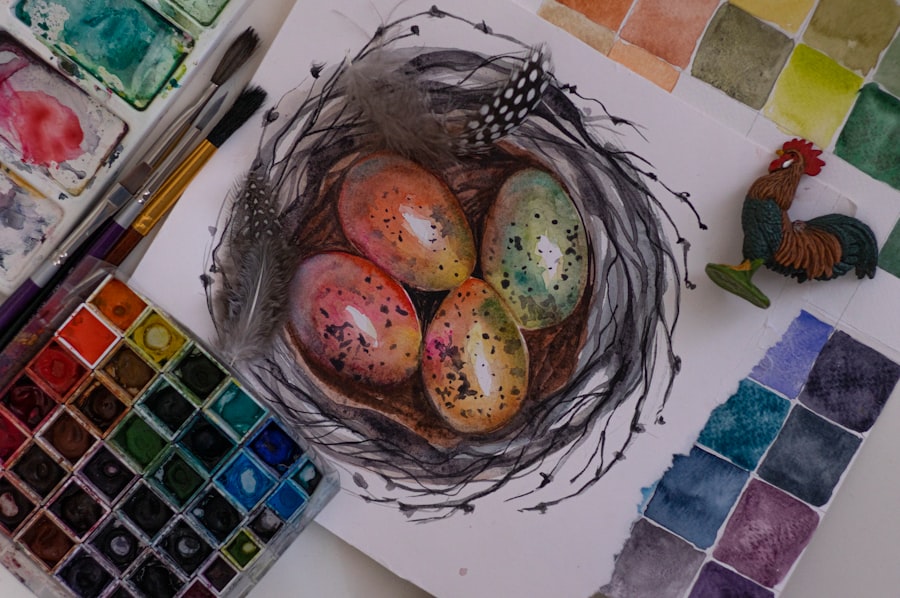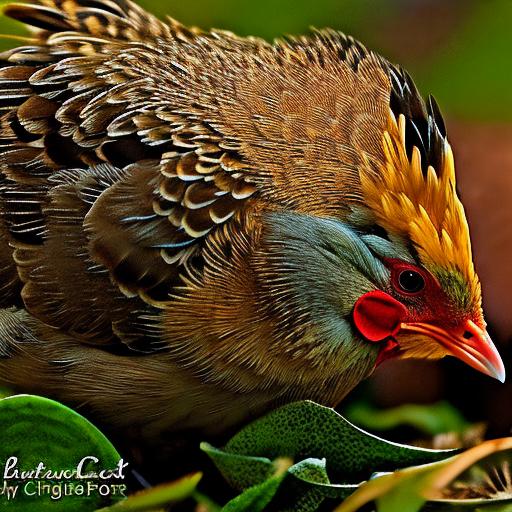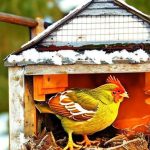Keeping chickens in the shade refers to providing a shaded area for your chickens to seek refuge from the sun and heat. This can be done by creating a shade structure or utilizing existing structures such as trees or buildings. Keeping chickens in the shade has several benefits, including protecting them from extreme heat and sunburn, preventing dehydration and heat stress, and providing a comfortable environment for them to lay eggs.
Key Takeaways
- Keeping chickens in the shade can provide numerous benefits, including protection from extreme heat and sunburn.
- Before keeping chickens in the shade, it’s important to consider factors such as the size of your flock and the climate in your area.
- Choosing the best shade for your chickens involves selecting a location that provides ample shade throughout the day and is protected from predators.
- Building a shade structure for your chickens can be done using a variety of materials, including wood, PVC, and shade cloth.
- Adequate ventilation is crucial when keeping chickens in the shade, as it helps to prevent the buildup of harmful gases and moisture.
Benefits of Keeping Chickens in the Shade
One of the main benefits of keeping chickens in the shade is protecting them from extreme heat and sunburn. Chickens are susceptible to heat stress, especially during hot summer months. By providing them with a shaded area, you can help regulate their body temperature and prevent them from overheating. Additionally, chickens can also suffer from sunburn, particularly on their combs and wattles. Shade can provide them with protection from harmful UV rays.
Another benefit of keeping chickens in the shade is preventing dehydration and heat stress. Chickens need access to fresh water at all times, especially during hot weather. By providing them with a shaded area, you can help keep their water cool and prevent it from evaporating too quickly. This will ensure that your chickens stay hydrated and reduce the risk of heat stress.
Furthermore, shade can provide a comfortable environment for your chickens to lay eggs. Extreme heat can disrupt their egg-laying patterns and decrease egg production. By keeping them in the shade, you can create a more favorable environment for egg-laying. This is particularly important if you are raising chickens for their eggs.
Factors to Consider Before Keeping Chickens in the Shade
Before deciding to keep your chickens in the shade, there are several factors you should consider. First, you need to assess the climate in your area and how it affects your chickens. If you live in an area with mild temperatures year-round, providing shade may not be as critical. However, if you live in an area with hot summers, it is essential to provide shade to protect your chickens from heat stress.
Second, the breed of chickens you have will also play a role in determining their specific shade needs. Some breeds are more heat-tolerant than others and may require less shade. It is important to research the specific needs of your breed and adjust your shade structure accordingly.
Lastly, the size of your flock will also affect the amount of shade needed. If you have a small flock, a simple shade structure may be sufficient. However, if you have a large flock, you may need to provide multiple shade structures or a larger structure to accommodate all of your chickens.
Choosing the Best Shade for Your Chickens
When it comes to choosing the best shade for your chickens, there are several options to consider. The most common types of shade structures include umbrellas, tarps, and permanent structures such as awnings or roofs.
Umbrellas are a popular choice for providing temporary shade. They are portable and can be easily moved around to different areas of your chicken coop or run. However, they may not provide as much coverage as other types of shade structures and may need to be adjusted throughout the day to ensure adequate shade.
Tarps are another option for providing shade. They can be attached to existing structures or supported by poles to create a shaded area. Tarps are relatively inexpensive and easy to install. However, they may not be as durable as other types of shade structures and may need to be replaced more frequently.
Permanent structures such as awnings or roofs offer a more permanent solution for providing shade. They can be attached to the sides of buildings or constructed as standalone structures. Permanent structures provide consistent shade and protection from the elements. However, they require more planning and construction compared to other options.
When choosing the best shade structure for your chickens, consider factors such as durability, ease of installation, and the specific needs of your flock. It is also important to ensure that the shade structure is securely anchored to prevent it from being blown away by strong winds.
How to Build a Shade Structure for Your Chickens
If you decide to build a shade structure for your chickens, here is a step-by-step guide to help you get started:
1. Determine the location: Choose a suitable location for your shade structure. Consider factors such as proximity to the chicken coop or run, availability of shade throughout the day, and ease of access.
2. Gather materials: Depending on the type of shade structure you choose, gather the necessary materials. This may include poles, lumber, screws or nails, and shade cloth or tarp.
3. Measure and mark: Measure and mark the dimensions of your shade structure on the ground. This will help you visualize the size and layout before starting construction.
4. Dig holes: If you are using poles to support your shade structure, dig holes at each corner of the marked area. The depth of the holes will depend on the height of your shade structure.
5. Install poles: Place the poles in the holes and secure them with concrete or soil. Ensure that they are straight and level.
6. Attach cross beams: Attach cross beams to the top of the poles to create a frame for your shade structure. Use screws or nails to secure them in place.
7. Install shade cloth or tarp: Attach shade cloth or tarp to the frame using clips or ties. Ensure that it is stretched tightly to provide maximum coverage.
8. Secure structure: Check that all connections are secure and make any necessary adjustments. Test the stability of the structure by gently shaking it.
9. Test for shade coverage: Observe how the shade structure casts shadows throughout the day to ensure that it provides adequate coverage for your chickens.
10. Make adjustments if needed: If you find that the shade structure does not provide enough coverage, make any necessary adjustments. This may include adding additional shade cloth or relocating the structure to a different area.
Providing Adequate Ventilation in the Shade

While shade is important for protecting your chickens from the sun and heat, it is equally important to provide adequate ventilation in the shade structure. Proper ventilation helps remove excess heat and moisture from the coop or run, ensuring a comfortable environment for your chickens.
To provide adequate ventilation, consider the following:
1. Positioning: Place your shade structure in an area that allows for natural airflow. Avoid placing it in a confined space or against a solid wall that may restrict air movement.
2. Openings: Incorporate openings such as windows or vents in your shade structure to allow for air circulation. These openings should be positioned to take advantage of prevailing winds.
3. Size: Ensure that your shade structure is large enough to accommodate your flock comfortably. Overcrowding can lead to poor air quality and increased humidity.
4. Cleanliness: Regularly clean out any debris or droppings from the shade structure to prevent the buildup of ammonia and other harmful gases.
Signs of poor ventilation include excessive moisture, foul odors, and respiratory issues in your chickens. If you notice any of these signs, it is important to address the ventilation issue promptly. This may involve adding additional openings or increasing the size of existing ones.
Feeding and Watering Your Chickens in the Shade
Feeding and watering your chickens in the shade is essential to ensure their health and well-being. Here are some tips to consider:
1. Provide food and water in shaded areas: Place feeders and waterers in shaded areas within your coop or run. This will help keep them cool and prevent them from overheating.
2. Keep food and water clean: Regularly clean and refill feeders and waterers to prevent the growth of bacteria and algae. Chickens are more likely to consume fresh, clean water and food.
3. Prevent pests: Take measures to prevent pests such as flies or rodents from accessing your chickens’ food and water. Use feeders and waterers with lids or covers, and regularly clean up any spilled food or water.
4. Monitor consumption: Keep an eye on your chickens’ food and water consumption. If you notice a decrease in consumption, it may be a sign of heat stress or other health issues.
Maintaining Cleanliness in the Shade
Maintaining cleanliness in the shade structure is important for the health and well-being of your chickens. Here are some tips to help you keep the shade structure clean:
1. Regularly remove debris: Remove any debris such as leaves, feathers, or droppings from the shade structure. This will help prevent the buildup of harmful bacteria and parasites.
2. Clean with mild detergent: Use a mild detergent or disinfectant to clean the shade structure periodically. This will help kill any bacteria or parasites that may be present.
3. Rinse thoroughly: After cleaning, rinse the shade structure thoroughly with clean water to remove any residue from the detergent or disinfectant.
4. Allow to dry: Allow the shade structure to dry completely before allowing your chickens back in. This will help prevent the growth of mold or mildew.
Signs of poor cleanliness include foul odors, excessive flies or other pests, and an increase in respiratory issues in your chickens. If you notice any of these signs, it is important to address the cleanliness issue promptly.
Common Problems and Solutions When Keeping Chickens in the Shade
While keeping chickens in the shade has many benefits, there are also some common problems that can arise. Here are a few examples and their solutions:
1. Overheating: If your chickens are still showing signs of heat stress despite being in the shade, you may need to provide additional cooling methods such as misters or fans. Ensure that these methods are safe and do not pose a risk to your chickens.
2. Poor ventilation: If you notice signs of poor ventilation such as excessive moisture or foul odors, you may need to add additional openings or increase the size of existing ones. Consult with a professional if needed.
3. Pest infestation: If you are experiencing issues with pests such as flies or rodents, take measures to prevent their access to your chickens’ food and water. This may involve using traps or repellents, or consulting with a pest control professional.
4. Mold or mildew: If you notice the growth of mold or mildew in your shade structure, thoroughly clean and disinfect the affected areas. Ensure that the structure is properly ventilated and allow it to dry completely before allowing your chickens back in.
If you encounter any other problems when keeping chickens in the shade, it is important to address them promptly. Consult with a veterinarian or poultry expert if needed.
Is Keeping Chickens in the Shade Right for You?
Keeping chickens in the shade has several benefits, including protecting them from extreme heat and sunburn, preventing dehydration and heat stress, and providing a comfortable environment for egg-laying. However, before deciding to keep your chickens in the shade, it is important to consider factors such as the climate in your area, the breed of chickens you have, and the size of your flock.
If keeping chickens in the shade fits your needs and lifestyle, there are several options for providing shade, including umbrellas, tarps, and permanent structures. It is important to choose the best shade structure based on your specific needs and ensure that it provides adequate coverage for your flock.
Additionally, proper ventilation, feeding and watering practices, and cleanliness are essential when keeping chickens in the shade. Regularly monitor your chickens for signs of heat stress, poor ventilation, or other health issues, and address any problems promptly.
Overall, keeping chickens in the shade can be a rewarding and beneficial practice. It provides a comfortable and safe environment for your chickens, ensuring their health and well-being.
If you’re wondering about the best way to keep chickens in the shade, you might find this article on Poultry Wizard helpful. They provide a range of useful information on chicken coops and nest boxes, including tips on how to create a comfortable and shaded environment for your feathered friends. Check out their article on chicken coop nest boxes for some practical advice. Additionally, if you’re considering converting a shed into a chicken coop, Poultry Wizard has another informative article that you might find interesting: turning a shed into a chicken coop. And if you’re looking for ideas for a large chicken coop with ample shade options, they also have an article on large chicken coop ideas. Happy reading and happy chicken keeping!
FAQs
What are the benefits of keeping chickens in the shade?
Keeping chickens in the shade can help regulate their body temperature, prevent heat stress, and reduce the risk of dehydration. It can also provide a comfortable environment for them to rest and lay eggs.
What are the ideal conditions for keeping chickens in the shade?
Chickens need access to shade, fresh water, and good ventilation. The shade should be cool and well-ventilated, and the area should be free from predators and other hazards.
What are the best types of shade for chickens?
The best types of shade for chickens are natural shade from trees or shrubs, or artificial shade from a canopy or shelter. The shade should be large enough to accommodate the number of chickens you have and should be positioned in a way that allows for good air flow.
What are the risks of keeping chickens in the shade?
The main risk of keeping chickens in the shade is that they may not get enough sunlight to produce vitamin D, which is essential for their health. To prevent this, it is important to provide them with access to sunlight for at least a few hours each day.
What are some tips for keeping chickens in the shade?
Some tips for keeping chickens in the shade include providing them with plenty of fresh water, ensuring good ventilation, and monitoring their behavior for signs of heat stress. It is also important to keep the area clean and free from hazards, such as sharp objects or toxic plants.
Meet Walter, the feathered-friend fanatic of Florida! Nestled in the sunshine state, Walter struts through life with his feathered companions, clucking his way to happiness. With a coop that’s fancier than a five-star hotel, he’s the Don Juan of the chicken world. When he’s not teaching his hens to do the cha-cha, you’ll find him in a heated debate with his prized rooster, Sir Clucks-a-Lot. Walter’s poultry passion is no yolk; he’s the sunny-side-up guy you never knew you needed in your flock of friends!







